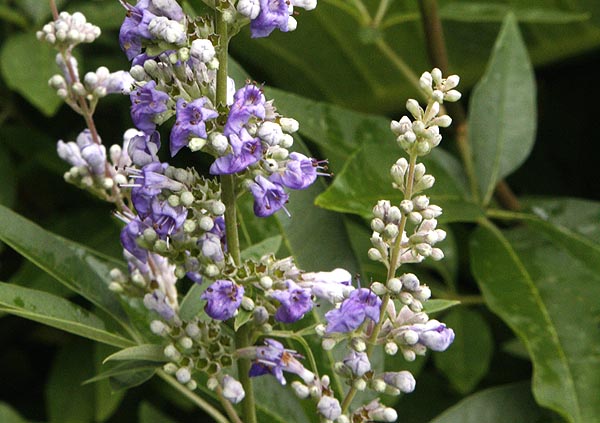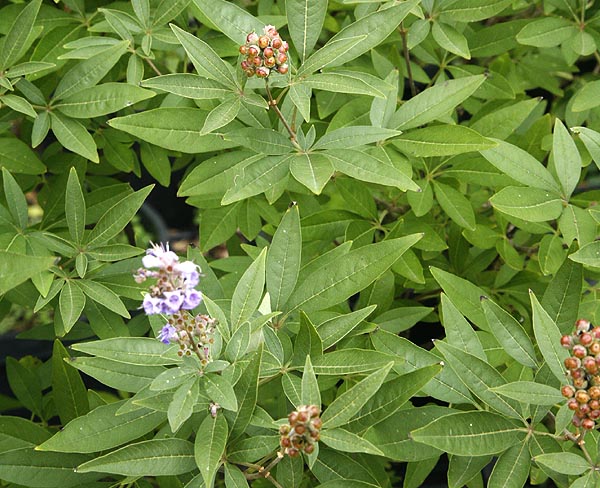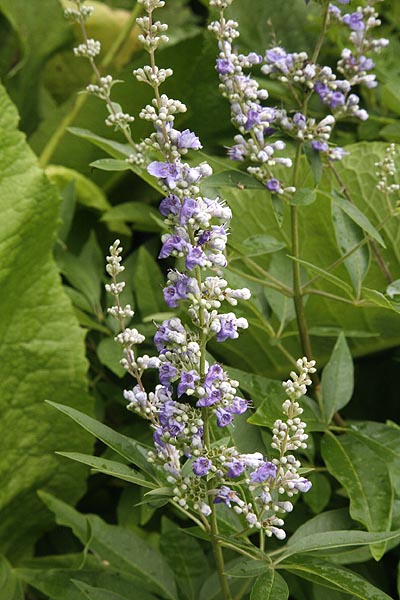Stunningly beautiful shrub that will produce spikes of blue flowers from early summer until frost with most blooms being in summer. Its very drought tolerant and once established will still flower even in when there is no water. Tough and hardy to zone 5 although it may die back to the ground in very cold areas. It has delicate looking blue green aromatic leaves making the plant look very airy and exotic. Butterflies and pollinators love the beautiful flowers but deer and rabbits don't eat it. Easy to grow it does need a little pruning to keep flowering at its best. It does not have much in the way of disease or pest problems and is actually repellent to many biting insects making it a great plant to have near a seating area. It flowers when most other shrubs are not and its extremely tough. Grows rapidly from seed. A truly delightful plant.
Description of Chase Tree (Vitex agnus castus).
Chaste Tree is an unusual plant in that it can be a tree, bush or even a herbaceous perennial depending on the climate in which it is grown. In warm southern areas it can become a tree growing to 20 feet (6 m). In more temperate zones it can be a deciduous shrub from 10 - 15 feet (3-4.5m) tall. In colder zones 5-6 it may only grow to 3- 5 feet (1-1.5m) in height and above 5, or even in 5a it may act as a herbaceous perennial dying down to the ground every year. In colder zones 5b and colder it may need extra mulching and protection to survive.
A lovely deciduous shrub or tree it has beautiful fragrant leaves. These are palmate (like an open hand) or possibly star shaped consisting of five to seven radiating leaflets borne on long stems which attach to the main stem in opposite pairs. Each leaflet can be 1 - 2 ½" (2.5-6.5 cm) long and are lance shaped with serrated edges. They are blue green to gray green above and lighter and more gray below with a close lying felt beneath. In mid summer flower spikes arise from the ends of branches that can be from 2- 10" (5-25 cm) long and consist of whorls of small bright blue flowers. Chaste tree can continue to flower up until frost although most flowers are produced in summer and can completely cover the shrub. Flowers are followed by berries the size or peppercorns that begin green and ripen to dark purple then brown. The berries have the same aromatic odor as the leaves. The flowers also have an interesting aroma and are extremely attractive to butterflies and bees. Chaste tree is often planted to assist in apiculture. Deer and Rabbits don't eat it.
Growing Chase Tree (Vitex agnus castus) from Seed.
Starting indoors is recommended. While easy to grow the seeds do need a warm environment to germinate. If starting early a heating mat is suggested or above a radiator or other source of warmth. Seeding in a cold greenhouse should not be until the temperatures are enough to heat the soil to a fairly warm temperature. Some suggest light is needed for germination but we have not found this to be the case. In an warm environment seedlings usually sprout within 2-3 weeks. Some research has been done suggesting that treatment with hot water for a few moments or leaving seeds in a warm dry place for several hours before planting can increase germination rates. (we have yet to try this).
Grow plants in small individual pots or large cell trays as seedlings grow quickly but since germination can be erratic some plants need to be removed before others. Seedlings grow rapidly and can reach several feet in one year.
Location and Care of Chase Tree (Vitex agnus castus).
Needs full sun and well drained soil. Not fussy about soil types and is quite drought tolerant once its established. In warmer areas (zone 8 and more) it can grow to tree height if left unchecked. Zones 6-7 it usually forms a medium sized deciduous shrub while zone 5 and above it may die back to the ground in winter and re-sprout in spring. Mulching roots well in zones 5 and higher will aid survival. Planting in sheltered warm pocket in zones 5 will also increase survival prospects.
Do not overwater as plant will produce less flowers and more leaves when ample water is available. Plant in semi dry location and water infrequently if no rain. Pick a location where you can easily admire the beauty of this shrub throughout the summer.
Does not need much feeding, will survive well on poor soils. Perhaps a little leaf mulch each fall would be helpful. Tolerant of almost any soil type but wet. Is ideal for hotter dry areas where other shrubs will not grow.
Pruning Chase Tree (Vitex agnus castus).
The downside is that Chaste tree does need to be pruned if you want the best flowering. Flowers are produced on new branches so cutting the shrub back in late winter or early spring (December to March ) will ensure the best possible flower production. It also keeps the shrubs small enough to harvest if that is desired or just to appreciate the butterflies at a height you can see them.
The plant can be trained in may different ways from a small multi trunked shrub to a single trunk or can be shaped however you choose.
Harvesting Chase Tree (Vitex agnus castus).
Fruits are best harvested while they are still green to light purple, don't wait until they have gone brown. Harvesting is easy just strip the whole spike by sliding it through the hand and stripping berries.
Culinary Uses of Chase Tree (Vitex agnus castus).
Both the leaves and fruit are used as a spice in some dishes especially those from Morocco and some Mediterranean countries. The fruit is also used as a pepper substitute.
Medical uses of Chase Tree (Vitex agnus castus).
One of the most important herbs for balancing female hormones. It is used extensively to aid in restoring correct estrogen and progesterone balance. This is effective for treatments of Premenstrual syndrome (PMS), Heavy menstrual periods, Menopausal symptoms, Infertility in women and restoring absent menstruation. One use is for those stopping oral contraception, chaste tree is used to help reestablish normal menstruation and ovulation. Some reports state that chaste tree is a aphrodisiac while others state it is a anaphrodisiac. It is likely that chaste tree is restoring a more even balance so those with little libido gain some and those with too much have it reduced. It has also been used effectively in treating Acne, Fibrocystic breast disease, Benign prostatic hyperplasia, Migraines and Joint conditions. Most likely all caused by hormone imbalances. More recent studies have suggested it use in treatment of some kinds of cancer.
Headache, abdominal cramps and diarrhea, increased menstrual flow, rashes, pruritus and formication which manifests as a sensation of insects crawling over the skin.
Other uses of Chase Tree (Vitex agnus castus).
Extract of the seeds of the plant have proven to be highly efficacious as a repellent against ticks, fleas, mosquitoes and biting flies.
The highly aromatic leaves and flowers are used to make perfume while a yellow dye can be obtained from the leaves, the seed and the roots. The young stems have been used to make baskets
Native to Greece and Italy this plant has been used for centuries. While the hormone balancing was not really understood as we do today they did not that it affected the libido and would give portions of the berries to maidens to aid in securing chastity. Hence the name Chaste Tree. They would also strew the leaves in beds and bedroom floors purportedly to promote chastity but also perhaps (more probably) since it has such effects on biting insects to keep ticks, fleas and bed bugs away.
Agno Casto, Agnocasto, Bish Barmagh Aghaji, Chaste Tree, Daribrahim, Gatilier, Hayit, Hemp Tree, Kaff Maryam, Keuschlamm, Lilac Chastetree, Lygos, Monk'S Pepper, Monk's Pepper Tree, Monks Pepper, Panjangusht, Pepper, Monks, Poivre De Moine, Ranukabija Sauzgatillo, Seiyo-Ninzin-Boku, Shajerat Ebrahim, Lilac chaste tree, chasteberry.








